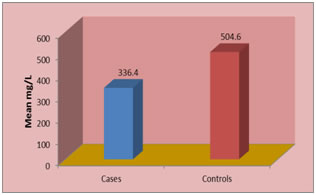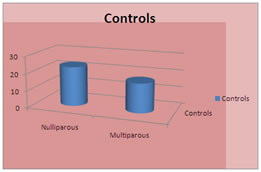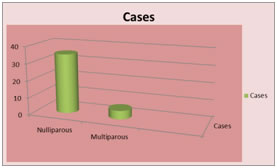Official Journals By StatPerson Publication
|
Table of Content - Volume 7 Issue 2 - August 2018
Role of serum ferroxidase activity of ceruloplasmin in preeclampsia
Shakuntala Masti
Assistant Professor, Department of Biochemistry, S.S Institute of Medical Sciences and Research Centre, Davangere -577004, Karnataka, INDIA. Email: shaku.jkd94@yahoo.com
Abstract Aim: To assess the role of ferroxidase activity of ceruloplasmin in women with preeclampsia. Materials and Methods: This study comprised of 40 preeclamptic cases and 40 age matched controls without having preeclampsia. Results: Mean serum ferroxidase activity of ceruloplasmin levels were lower in cases (336.4 ± 134.7 mg/l) as compared to controls (504.6±184.8mg/l) (P<0.001) which is statistically significant. Conclusion: The study revealed that decreased ferroxidase activity of ceruloplasmin level is strongly associated with the occurrence of Preeclampsia. Key Word: Ferroxidase activity of ceruloplasmin, oxidative stress, preeclampsia
INTRODUCTION Normal pregnancy is a state of an increased oxidative stress when compared with nonpregnant women and gradual increase in the antioxidant activity over occurs as normal pregnancy advances.1 Organisms of pregnant woman and fetus are especially sensitive to various stress-factors effecting a human being with increasing intensity. Effect of harmful agents causes metabolic disorders, functional disorders of tissues and organs, disorder of fetus-placenta homeostasis, the development of early and late toxicosis of pregnancy, abortion, still birth.2 Numerous facts suggest that diverse complications of pre-eclampsia, including vascular reactivity alterations, vascular spasm and multiorganic pathologies, are caused by pathological changes in the maternal vascular endothelium.3,4 Preeclampsia is defined as blood pressure of ≥140/90mm of Hg noted for the first time during pregnancy on ≥2 occasions at least 6 hours apart, associated proteinuria of ≥300mg/ 24 hours or ≥1+ by dipstick method in a random urine sample.5 In India incidence of preeclampsia is about 5-6% of total pregnancy. Incidence in primipara women is 4 times greater than that in multipara women.6,7 Preeclampsia accounts for about one quarter of maternal mortality and second cause of maternal deaths associated with pregnancy.8 Preeclampsia is a common, pregnancy-specific syndrome defined by the clinical findings of elevated blood pressure, proteinuria, and edema. This disease is thought to be attributable to generalized endothelial dysfunction during pregnancy.9 Serum ceruloplasmin and serum transferrin through its capacity to bind with iron, apart from their traditional role in iron metabolism, behave like acute-phase reacting proteins, and may limit oxidant induction on tissue injury. The beneficial action of ceruloplasmin is due to its antioxidant capacity which, paradoxically, is related to this ferroxidase activity10,11 The total iron binding capacity of serum, as well as the serum levels of ceruloplasmin increase as gestation progresses. Thus, variations in these antioxidants in patients with pre-eclampsia may be of considerable clinical importance.12 The aim of this study is to determine altered antioxidant activity of ceruloplasmin in women with preeclampsia when compared to normal pregnant women.
MATERIAL AND METHODS We selected 40 cases and 40 controls for this study based on inclusion and exclusion criteria. Inclusion Criteria Controls- 40 age matched healthy pregnant women of ≥20 weeks of gestation without any major illness. Cases- 40 proven cases of preeclampsia in age group of 20-45 years Pregnant female of ≥20 weeks of gestation with blood pressure ≥140/90 mm of Hg noted first time during pregnancy on ≥2 occasions at least 6 hours apart. Exclusion Criteria: Pregnant women With chronic hypertension that was present before pregnancy.
Based on the inclusion and exclusion criteria, age matched cases and controls were included in the present study after obtaining informed consent. A proforma was used to record relevant information e.g. patient’s data, investigation reports, etc. Collection of blood samples for the study: 3ml of venous blood was collected under aseptic precaution in a sterile bulb from cases and controls. Serum was separated by centrifugation which was used for estimation of concentration of ferroxidase activity of ceruloplasmin. Ferroxidase activity of Ceruloplasmin estimated using p-Phenylenediamine Oxidase (PPD) method using sphectrophotometer.12
RESULTS A total of 40 cases and 40 controls were studied. Table a shows the mean age and mean POG of controls and cases were similar which was statistically not significant. This table b showed the mean concentrations of serum levels of ferroxidase activity of ceruloplasmin of controls are 504.6 ± 184.8 mg/l with range of 220.0 - 983.2 mg/l and the mean concentrations of serum levels of ferroxidase activity of ceruloplasmin of the cases are 336.4 ± 134.7 mg/l with the range of 106.0 - 632.0mg/l respectively.
Table 1
Graph A: Comparison of serum Ferroxidase activity of ceruloplasmin levels among study groups The statistical analysis by unpaired student’s t-test showed that mean concentration of serum level of of ferroxidase activity of ceruloplasmin significantly decreased in subjects with preeclampsia when compared with controls (p<0.001). Table b, Graph b and Graph c showed the comparison of parity among women with normal pregnancy and preeclampsia showed in both the groups, majority of subjects were nulliparous. 80% of women with preeclampsia were nulliparous.
Table 2:
Graph B: The comparison of parity among women with normal pregnancy
Graph C: The comparison of parity among women with preeclampsia DISCUSSION Hypertensive disorders of pregnancy continue to be one of the leading causes of high rates of maternal and perinatal mortality and morbidity. Hypertensive disorders are common and form one of the deadly triad along with hemorrhage and infection that results in much of the maternal morbidity and mortality related to pregnancy. Worldwide, 50,000 women die each year because of pre-eclampsia.13 This study was undertaken to assess ferroxidase activity of ceruloplasmin as a marker of decreased antioxidant activity in preeclampsia which included 80 pregnant women after 20 weeks of gestation. Among them 40 subjects were taken as controls which included normal healthy pregnant women, 40 preeclamptic women were taken as cases. Both nulliparous and multiparous pregnant women were included in this study. In both the study groups serum concentrations of Ferroxidase activity of ceruloplasmin levels were estimated. The mean concentrations of serum levels of ferroxidase activity of ceruloplasmin in controls are 504.6 ± 184.8 mg/l with range of 220.0 - 983.2 mg/l respectively and in the cases 336.4 ± 134.7 mg/l with the range of 106.0 - 632.0 mg/l. In the present study it was found that the mean levels of serum Ferroxidase Activity Of Ceruloplasmin are significantly decreased in subjects with preeclampsia when compared to healthy controls (p < 0.001). These findings are in accordance with the studies of Carl A Hubel et al14 and N.Vitoratos et al.1 They quoted that ceruloplasmin and transferrin act in concert to effectively eliminate iron catalysed free radical activity in the normal circumstances. Ceruloplasmin converts Fe++ to Fe+++ by iron- oxidising by ferroxidase activity and apotransferrin binds Fe+++ with high affinity to reduce free radical generation. They also concluded that iron bound to transferrin does not induce free radical production. L. Shakour-Shahabi et al8 stated that the antioxidant activity of Ceruloplasmin decreases with increasing transferrin saturation by iron. Increased transferrin saturation and decreased unsaturated iron binding capacity in preeclampsia may occur consequent to oxidative stress and then further promote oxidative stress by decreasing serum antioxidant buffering capacity against redox- active iron. Tinatin Khetsuriani et al2 found that in pre-eclampsia a significant rise of ceruloplasmin indicates the activation of oxidative processes in the organism and lowered antioxidant defense of blood. An increase of oxidised ceruloplasmin causes reduction of ferroxidative activity, which become apparent by drastic decrease of Fe3+-transferrin in blood and accumulation of Fe2+ ions in serum. This study suggested that in women with pre-eclampsia, the intensification of free radical oxidation results in disturbances of antioxidant defense ceruloplasmin –Fe3+-transferrin enzymatic system function and contribute to an increase in vascular resistance and the development of endothelial dysfunction. Louro MO et al study found that the ferroxidase activity of ceruloplasmin was significantly lower in women with normal pregnancy compared to non-pregnant women15. B. Halliwell et al study stated that the major antioxidant action of human plasma is to bind transition metal ions such as iron and copper, in forms that will not stimulate free radical reactions. This binding is achieved by antioxidants such as lactoferrin, ceruloplasmin, albumin, uric acid and hemopexin16 N. Vitoratos et al study found that although women with pre-eclampsia show significantly higher levels of serum ceruloplasmin, the ferroxidase activity is not significantly higher when compared to that of normal women. It seems that during pre-eclampsia the ferroxidase activity does not increase proportionally with the levels of ceruloplasmin and this may indicate a dysfunction on the part of ceruloplasmin1 Vanita Gowda et al study quoted that significant correlation was found between the increase in uric acid levels and ceruloplasmin in preeclamptic women. Since uric acid has been shown to induce inflammatory response and ceruloplasmin is also considered as acute phase inflammatory response marker, increased ceruloplasmin levels are suggestive of exaggerated inflammatory response in preeclampsia.17 Our present study shows that decreased Ferroxidase activity of ceruloplasmin is important finding in women with preeclampsia. Estimation of serum ferroxidase activity of ceruloplasmin can be helpful to assess the progression of the disease. A cohort study can be done taking pregnant women in early gestation as study subjects and the women with decreased ferroxidase activity of ceruloplasmin can be followed up for the occurrence and progression of these diseases.
CONCLUSION Preeclampsia is a complex multisystem disorder characterized by widespread endothelium dysfunction There is significantly decreased concentration of serum levels of ferroxidase activity of ceruloplasmin in women with preeclampsia compared to normal pregnancy. Decreased serum levels of ferroxidase activity ofceruloplasmin lead to iron-dependent OH• formation in preeclampsia. This may increase lipid peroxidation in preeclamptic women. Decreased Ferroxidase activity of ceruloplasmin is present in women with preeclampsia and it may have a role in pathogenesis of this disease.
REFERENCES
|
|||||||||||||||||||||||||||
 Home
Home



